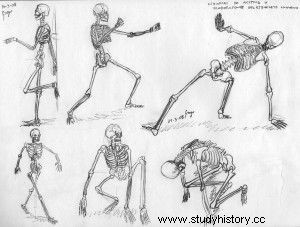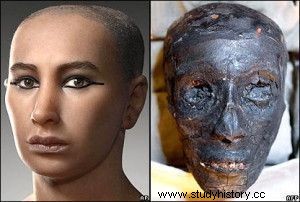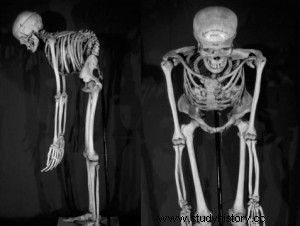
In fieldwork, depending on the type of burial, period, trousseau and anatomical postures , the individual will provide certain information about the community to which he belongs. In the laboratory is where we can learn more about the individual itself, taking into account their age, sex and height .
Thanks to technological advances applied to physical anthropology, their use in archeology is crucial. We can find out what face they had, what diseases they suffered from or what their work was within the community.
The first technological applications began in the 20th century in archaeology, at the hands of Howard Carter and the mummy Tuthmosis IV . He underwent an X-ray clandestinely in the maternity hospital in Cairo (the only one that owned this device). But it is not the only case, to the mummy of Ramses II Another non-destructive observation method called xeroradiography was applied. , when used on the skull, a tiny bone belonging to an animal could be seen inserted into the pharaoh's nose to support it. The mummies They have been the ones that have suffered the most anthropological studies, given the conservation of the skeleton and in some cases of soft tissues.

If we want to know what health possessed our ancestors, in some diseases it is possible to find out. The paleopathology takes care of this, and it is not an easy task since the soft tissues are not preserved in most cases and not all pathologies affect the bones. The conditions most likely to mark the bone are those related to joints, such as osteoarthritis or by accidents (traumas ) suffered by the individual in life. The war wounds They are very decisive when it comes to identifying an individual, as in the case of Filipo II that he could have suffered massive ankylosis caused by a spear wound, where his suffered limp would come from (see our post on the controversy of the new discovery of Philip II).
There are also characteristic cases of diseases that do leave a mark on the bone record, such as leprosy, syphilis and tuberculosis . For example, tuberculosis leaves a very characteristic trace, called Pott's disease (contraction of the spine).

On the other hand there are the anatomical variations , which are sometimes caused by cultural reasons. If we travel to South America it is very common to find among the pre-Hispanic elites morphologically altered skulls or decorations such as a dental embellishment in Bonampak (Mexico) made with jade.
We already know what sex, height, age and possible pathologies or ornaments our individual has. Now it's time to find out what he did on a daily basis and if this is recorded in the bones:the stress markers . If we currently suffer pain from repeating the same posture or activity repeatedly, before it was the same. For example, carrying heavy loads with one's own body causes a pronounced curvature or lumbago in the spine. Or like archers, who acquire shoulder modifications due to the dynamics of their movement.
As we mentioned, applications of physical anthropology are innumerable, and it provides information both at the individual level and to a community in general. In addition to studies of DNA , there are anatomical features that are identified with the different ethnic groups of the world and thanks to this paleodemographic studies can be carried out to know movements and origins of population. This branch of anthropology is called epigenetics.
Human beings generally feel the tendency to normalize any aspect that he faces. This action of normalizing is interpreted as establishing a common parameter and assigning it as a norm, for example, “it is normal to find sand on the beach”. Is it?
For forensic archaeology, the word “normal” is out of the dictionary . No two individuals are the same. And therefore the problems raised by this is far from normal. The forensic archaeologist must keep in mind that there are limits between skeletal and pathological variability. In the absence of normality, when is a bone considered to be affected by a disease or should it be understood simply as a variation in its skeleton? Some conventions, such as the XIII National Congress of Paleopathology to be held in Écija next October, address the need to establish parameters guidelines to facilitate to a certain extent the final diagnosis. But they are also aware that it is a difficult proposal. to solve.
Despite the fact that the bones generate problems among their investigators, we must always keep in mind that it is the closest thing that we have to know the citizen who walked through the streets of Rome, who fought in the Reconquest or who worked in the domestic tasks of the Middle Ages. And, therefore, they require special respect when working with them.
After all, the great civilizations and the not so big ones, are made up of individual people And if we don't study them correctly... why worry about knowing their context?
We are more than bones…
